http://www.digitiser2000.com/
They also seem to have an official YouTube channel, and... someone told me you can pay to have someone make you promotional videos like this. Awesome.
Hi everyone! Just here to give some updates about all of the goings-ons at the site for the past month.
A few people have asked if they were able to get copies of the Untold History of Japanese Game Developers book by donating through Patreon. Although HG101 promotes the book and we helped with its production, it's actually John Szczepaniak's project, so we're not at liberty to give anything away. However I've discussed it with him and he offered up discounts exclusively for Patrons at the $5+/month tier. For the book, you need to order directly from the Createspace site, as opposed to Amazon. The coupon will bring the price down to $29.99. Although you have to pay for shipping, overall it's about a $7 discount over the lowest price from over Amazon. Additionally, he's also offered discount prices for the DVD. It's normally 40 pounds but if donate, you'll be given access to a discount link which will lower the price to 30 pounds. If you've donated or are already a donor, I've already posted a section under "Activity" called "Discounts for Untold History of Japanese Game Developers", where you can find the coupon code and the discount link.
You can find some reviews of the book/DVD at Eurogamer, Black Falcon Games and Borders Down.
In the last couple updates I've discussed the Konami Shooter book, which is coming along nicely, but I also wanted to talk about the one every keeps asking me about: Sega Arcade Classics Vol. 2.
In the first volume, we focused primarily on popular franchises, along with a few other one-shots that we deemed noteworthy enough to include along with it, largely based on whether they were ported enough times. The main reason was, even though there is a "Volume 1" in the title, we weren't sure if the book would be successful enough to justify a "Volume 2", so we figured we'd load it with the titles most gamers were familiar with. The good news is that the reception was decent enough to justify a second volume, but on the other hand, the titles are probably not going to ring any bells. But that's okay! HG101 is about discovering new titles, and Sega put out a ton of interesting stuff in the 80s and 90s, most of which has been largely forgotten. So if you're the type that trawls through the MAME archives to find new and interesting things to play, this will definitely be for you, especially if you're a Sega fan.
The selection of games in Volume 2 falls into two basic categories:
(1) Arcade games from 1985 and prior. In the first volume, the earliest release game we focused on was Space Harrier, but there are a lot of games from before that period. These predated Sega consoles (at least the ones that were released worldwide, like the Sega Master System), so they be more familiar to Atari or Colecovision fans. The most prominent of these titles are Pengo, Turbo, Congo Bongo, Buck Rogers and the Planet of Zoom, and Zaxxon, along with others like Carnival, Borderline (AKA Underground), Up n' Down, and Subroc. There are a lot of other titles that fall into this category like Spatter, Flicky, Monaco GP, Ninja Princess, Super Locomotive, and many, many others. Sega also had a partnership with Coreland (in Japan) and Gremlin (in America) that put out a wide variety of strange, bizarre, largely unknown titles.
(2) Any arcade game from the late 80s and early/mid-90s that couldn't fit into the first volume. There were some titles like Bonanza Bros, SDI/Global Defense and Teddy Boy Blues that fell into the era covered in the first book, but we felt weren't quite well known enough to add in, since it would increase the cost to the point of unaffordability. Not all of these games were great. Some games like Bay Route, Tough Turf and Riot City are flagrant rip-offs of other titles at the time, but they're also really good rip-offs! Other games like Last Survivor, Dark Edge, Line of Fire, Laser Ghost and Rail Chase show off some extremely impressive technology, and occasionally have some really interesting ideas, that kind of games that are worth recognizing their efforts even though they're flawed.
Here are some very rough, early samples of what I've been working on:









I don't have anything close to a set release date for this just yet. There are two other books that will come first: the Konami Shooters book, which should hopefully be available at the beginning of 2015, and the HG101 Digest Vol. 1, a 75-ish page issue covering Bionic Commando, Strider, and several other features, will hopefully be available by the beginning of summer.
Some of the most noteworthy articles we've published this past month include: the first parts of Wizardry, the seminal CRPG series, coverage of which is still ongoing; Danganronpa, a series of stylish adventure games that totally justify the purchase of the Vita and are easily two of the best games I've played this year; Deae Tonosama Appare Ichiban, a campy SFC run-and-gun similar to Choaniki; Pier Solar and the Great Architects, the recently released HD update of the homebrew (yet quite professional) Genesis RPG; Elemental Master, a fantasy shooter by the same folks as Thunder Force; Smash TV / Total Carnage, the ultra violet twin stick arcade shooters from the 90s; and System Shock, the first person shooter/RPG hybrid that inspired Bioshock, and is the topic of this month's Game Club 199X.
Upcoming articles for October and early November include Charlie Ninja, Puzzle Boy, Boppin'. 64th Street: A Detective Story, Sentinel, Yumimi Mix, Chimera Beast, Martial Champion, King of Dragon Pass, New Zealand Story, and several Halloween themed entries towards the end of the month.
As always, thanks for reading and for your support!
First off, I'd like to extend a tremendous amount of gratitude for anyone who's donated to our site's Patreon. We've been running it for about a month now, so I thought I'd line out some of the changes we've implemented that have helped improve the site.
For starters, and you've probably already noticed this, the front page has been completely redesigned. The main reason behind this is that it makes updating much easier, since we don't need to write huge descriptions every time we update. In the past it was just me updating the main page, and I often only had time to get everything together on the weekends. We originally promised biweekly updates when we met out $500 funding goal, but between myself and fellow site admin Sam Derboo, we've exceeded that and have been hitting closer to three or four updates on a weekly basis. The extra money has helped funding the additional work required to get these updates in order. We've also worked our way (mostly) through our large posting backlog, so submitted articles will appear sooner. In the past, it often took up to three months before articles were officially posted, which I'm sure irritated some contributors, but the increased manpower has helped us become more efficient.
Additionally, we've also revised the site Submission Guidelines, which also outlines our revised payment rates. Initially they were kind of loose, typically about $15-$25 per game covered depending on the length, but with the help of the Patreon, we've revised them to, at the very least, double their original rates, and in the case of the longer pieces, nearly tripled. It's still not quite up as high as professional sites, but as contributions to the Patreon increase, we'll be increasing these too!
Note that all Patreon contributors of $5 or more get free digital copies of the books. If you've already contributed, check out the first post we made for links to the PDFs. You'll be receiving a free digital copy of the Castlevania book once it's completed too. A revised Kindle copy of the Guide to Classic Graphic Adventures is coming soon, as well as a previously unreleased Kindle version of Sega Arcade Classics Vol. 1. All contributors of the $10 tier or higher will get their names in all upcoming books, including the Castlevania one, so let me know if you want a different name added. All contributors at the $25 tier will also get a copy of the Castlevania book mailed to you, so make sure you have your address entered!
Finally, I'd like to share some previews of books that are currently in progress. The $2,500 goal is kind of a pie-in-the-sky goal that would allow me to work full time on these, and we're not quite there yet, but books will still be coming, albeit at a very slow pace. The Castlevania book should be out in the next month or two, so more details will be posted of that shortly, but in the mean time here are some other books:
HG101 Presents: Konami Shooters (Gradius, Parodius, TwinBee, etc.)
HG101 Presents: Sega Arcade Classics Vol. 2
HG101 Presents: Shin Megami Tensei
HG101 Digest Vol. 1 (includes full articles for Bionic Commando and Strider, as well as similar games, plus 80 JP PS1 games worth playing, a collectors guide to Genesis/Mega Drive games, the Dark Age of JRPGs, and more. Future editions will cover Taito arcade games)
I'll be posting more samples in the coming weeks so you get a feel of what we've planned.
Thanks again for all of your support, and we hope that the new HG101 will be deserving of your support!

So let's say that it's 2008 and you've achieved your lifelong dream as an employee at Konami, the company that made awesome games like Castlevania, Contra and Gradius. Hooray! Except, you're stuck making garbage portable anime tie-in games instead. Boo! What do you do to pass away the time? Why, you sneak classic Konami minigames in an otherwise completely unrelated title!
There are a few DS games based off of Hayate the Combat Butler. The first one, Boku ga Romeo de Romeo ga Boku de, is a basically a visual novel, where you read lots of dialogue and occasionally interact with the touch screen. It seems pretty banal - except, at the end of each chapter, you can play a minigame, almost all of them just involve hitting objects with the stylus. The goal is to get a high score and increase your "Pathos", which is used for unlocking costumes and other things in the main game. The five minigames are:

Gradius:
Orbs spawn randomly around the screen. Smash as many of them as possible with the style.

Gradius II:
Moai heads spit out a bunch of stuff, which also need to be smashed with the stylus.

Parodius:
Based off of the sumo pig boss from the mountain stage of Parodius, this panda trounces back and forth. He stomps on the ground, causing stuff to fall from the sky, which must be smashed with the stylus.

TwinBee:
Hit the clouds and juggle the bells.

Quarth:
The most in-depth game, and the only one that doesn't require the stylus (though you can use it), you play a quick game of the Konami puzzle shooter Quarth, where you have to shoot bricks at falling objects, turning them into rectangles and causing them to disappear. The visuals here seem to be taken from the Ganbare Goemon DS title, which included a similar, but more in-depth, Quarth minigame.
If you want to play these, you can just speed through the text in the main game, then hit the Minigame option in the menu. Since they're randomly chosen, you may want to save the game (using the battery save, not the save state), play the game, then reset and reload if you want to try something different. Alternatively, I'm attaching some save states for use with DESMume .9.7.2 which will let you play each of the five games.
Also, if the score tallying sound effect at the end of each game is from the original Castlevania.
Most Tokimeki Memorial games also included unique shooter games - you can read about some of them here.
Mugen no Shinzou (夢幻の心臓) - PC-88, PC-98, Mz-2500, S1 (1984)
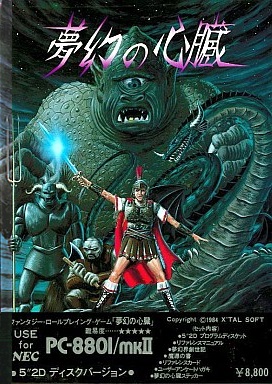
I promised we'd meet XTal Soft again soon, didn't I? Mugen no Shinzou ("Heart of Fantasy") is actually their first RPG and one of the most well-regarded Japanese computer RPGs. The Japanese Wikipedia entry on Hydlide describes it as one of the "big three" of Japanese CRPGs (the other two being Dragon Slayer and Hydlide), although that distinction may mostly come from its sequels. All in all, the series spans three titles, which were released about a year apart from each other.
Mugen no Shinzou was developed by Kazunari Tomo and one K. Kawahara. Lunar fans will probably remember the former as the creator of that series; after Mugen no Shinzou he did a few more games for Xtal Soft (including Mugen no Shinzou 2) before switching to Falcom, where he worked on Sorcerian and Dinosaur. As for Kawahara, I couldn't confirm 100% that it is the same person, but "K. Kawahara" appears credited for the Surlent scenario in Rudra no Hihou and a Katsuyoshi Kawahara directed the Final Fantasy remakes for PlayStation.
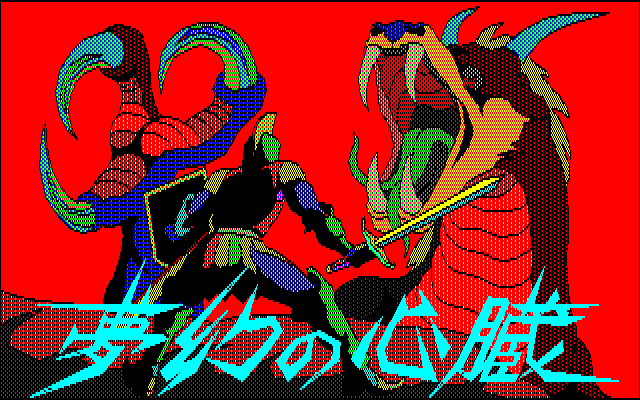
The game is also frequently cited as one of the influences for Dragon Quest. While I'm not sure Koichi Nakamura and Yuji Horii conceded as much directly (this lengthy conversation between Horii and his friend and later Dragon Quest collaborator Akira Sakuma seems to imply that they have at least played it), it sure does seem to make a lot of sense when playing it.
According to the plot, the protagonist is nearly killed in the real world, but gets rescued and spirited away by a god, ending up in a fantasy world full of dragons, goblins and other monsters. If those who enter don't find their way back to the real world soon, they are turned into monsters themselves and damned to eternal suffering. Thus the game actually has a "time" limit (although since the game is turn-based that translates to a turn limit) of 30,000 days. Moving every few steps advances the timer.
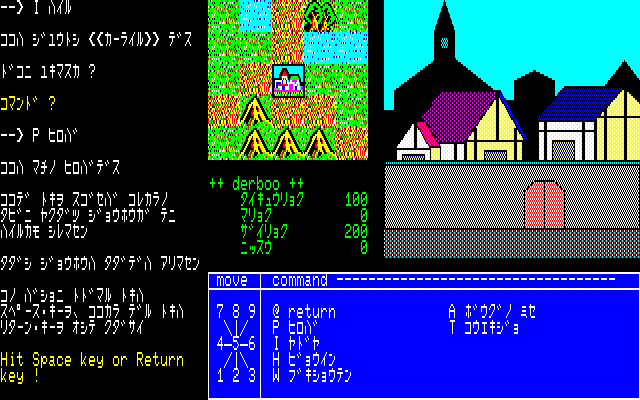
The game takes a lot of inspiration from Ultima, although like in Poibos the hero is merely a rectangle on a tiny window view of the map during overworld exploration. Another characteristic Mugen no Shinzou shares with Poibos is the fact that you won't survive most enemy encounters. At least the game starts next to a town, which is navigated in menu form. Resting in the inn to heal is fortunately quite cheap, but everything else is ridiculously expensive, resulting in the game's big similarity to Dragon Quest: It's basically just one huge, long, boring money grind.
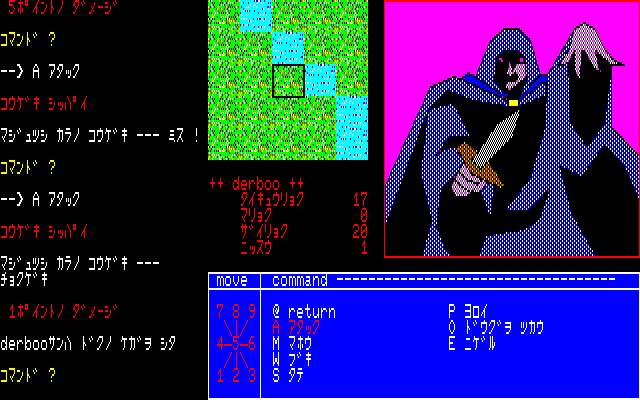
The first enemy I was actually able to defeat was the above thief, but he poisoned me before he went down, and curing poison costs a lot, so I ended up spending more money than I earned on the fight. Which I soon learned is characteristic for most fights in this game.
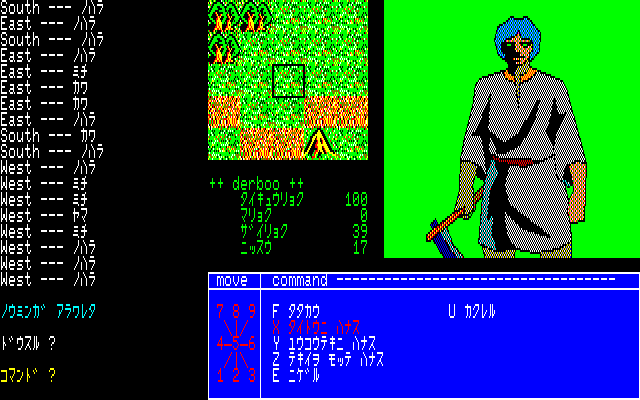
Then I finally happened upon a peasant. Human characters usually don't attack you rightaway, and you can choose between three different attitudes when encountering them. It's also possible to flee or hide on sight, but doing so costs a few experience points. Experience points don't seem to do anything, though, so it's not too bad a deal. The peasants probably are the most friendly enemies, but killing them really is the only way to make any (very slow) progress. The drop shit for money, but are not too hard to defeat, and if you're really lucky you can get their sickle to sell in town for like 25 gold pieces.
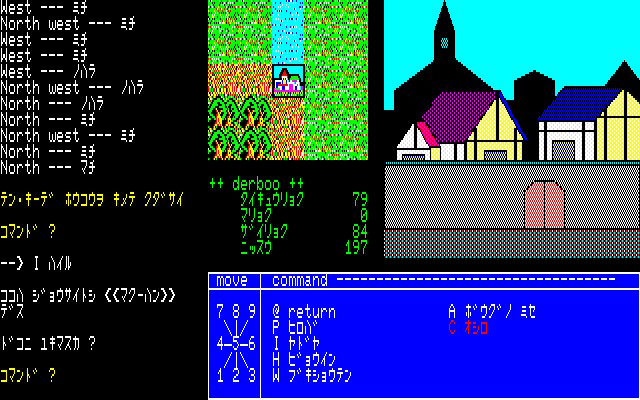
So after heroically slaughtering peasants for a few hours I saved up some money to spend. The most important stop in the town is the hospital. Here you can heal the hero entirely (which costs 100 gold vs the 4 gold to heal 25 points in the inn, so it's only worth it much later as you start with a mere 100HP), cure poison for 20 gold or extend the maximum amount of HP by a few. The next town you get to when traveling west has a castle. Getting an audience with the king costs 500 gold, so I never met him, but you can train strength, agility and dexterity, but the amount you can learn here is limited. At least it makes enough difference so you can successful fight most human enemies.
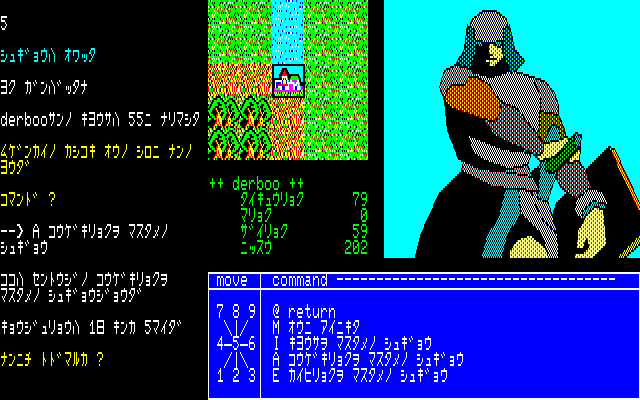
You may save for better weapons or armor to get a bit stronger, but you'll soon find out that every piece of equipment is destructible, and especially armor is so expensive that you better get used to fighting most battles naked and unarmed, until you get lucky and capture an enemy's weapon. Luck is a huge part of things, anyway, as the random factor is much too high. You may defeat an enemy with ease, only to get hopelessly slaughtered in the next encounter with the same type. There's not much tactics to the fights, either, as you got only one guy who can either attack, change his gear or try to escape. There's a "spell" option during combat, too, but I never got far enough to learn any magic.
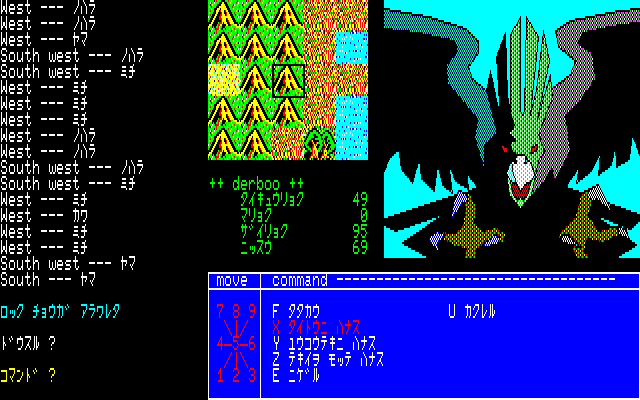
Don't ever run off the path, cause in the woods and mountains you're likely to get attacked by beasts, and they mean always trouble.
Sometimes when you're being nice to road encounters, they tell you some piece of information, usually the location of an interesting point of the map. I was directed to a poisonous well in the woods once, but usually the destination was a dungeon.
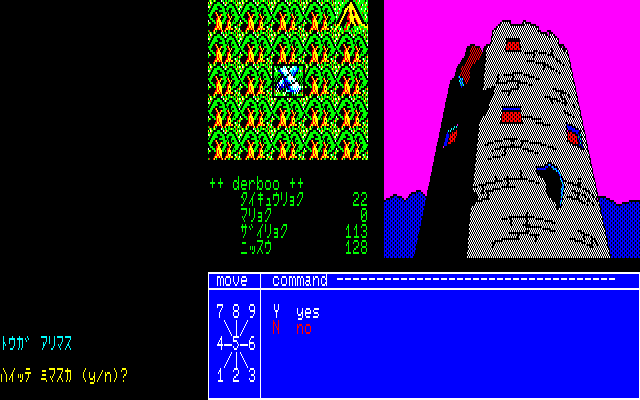
Entering here resulted in a pitch black graphics window, so I had to go back to town to buy a lamp and oil (at least there's no food management). This reveals a wireframe grid dungeon like in the early Ultima and Wizardry games. The tower I went into seemed rather huge, but had no distinguishing features other than a single trap right near the entrance, which just draws a lot of health when triggered. Apparently it's possible to get a map of the dungeons, but I never found one. The monsters here are quite a bit stronger than the human enemies outside (though nowhere near as destructive as the beasts in the wilderness), so usually after two or three fights I'm forced to back out. Mugen no Shinzou might be the most mechanically sound game I've played so far for this series, but the odds are still stacked far too heavily against the player. After 6-8 hours, I had just barely grinded my HP up to 200 and yet could barely make any money to get it up further.
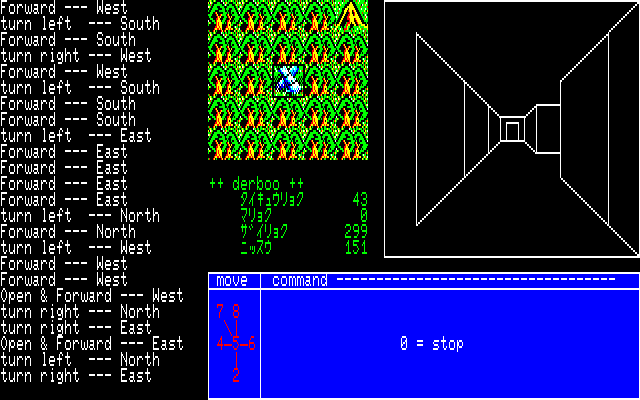
Xtal Soft have to be lauded for the graphics, though. The world map view and wireframe dungeons may not be too special, but the game contains a ton of detailed enemy graphics. I hardly got anywhere in this game, and still met more than 20 different enemies.
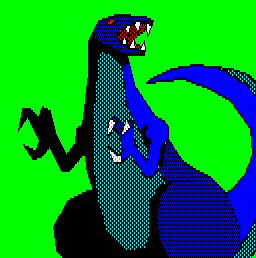
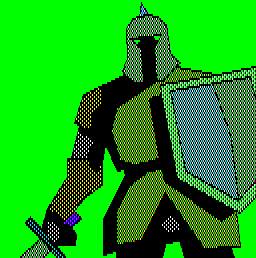
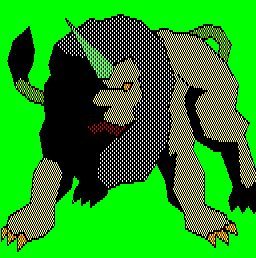
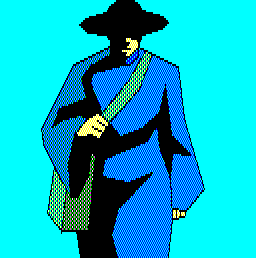
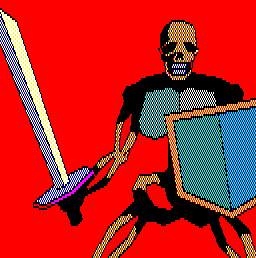
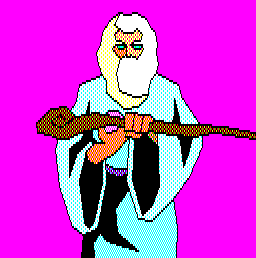
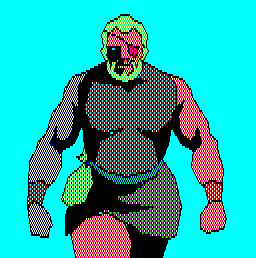
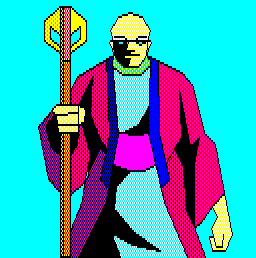

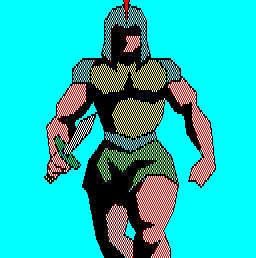
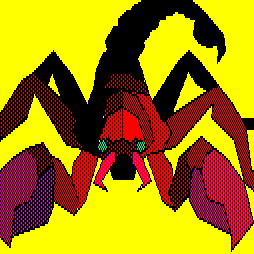
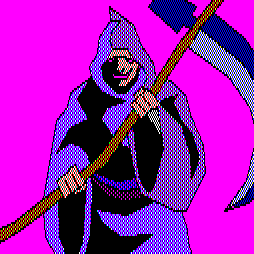
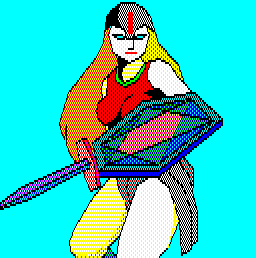
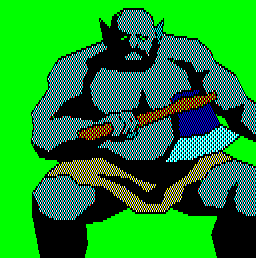
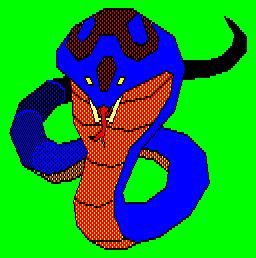
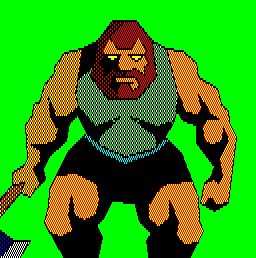
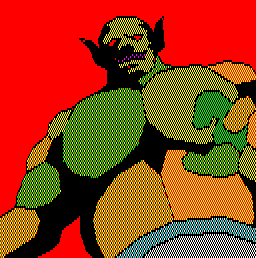
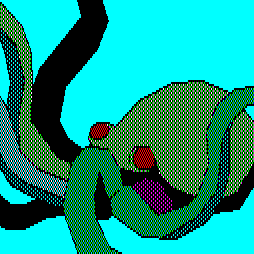
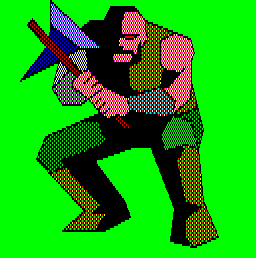
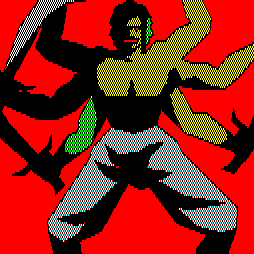
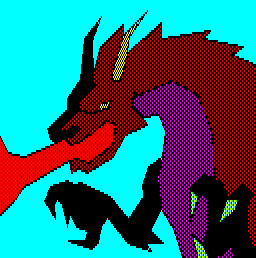
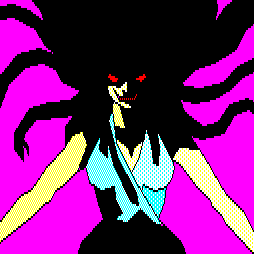
Here is a Japanese Blog of a guy who actually managed to finish this game. You can see some more great monster graphics in some of the later posts.
Previous Episodes:
(1) The Dragon and Princess
(2) Some games we cannot play
(3) Danchizuma no Yuuwaku (NSFW)
(4) Ken to Mahou
(5) Dungeon
(6) Seiken Densetsu
(7) Panorama Toh
(8) Do Dutch Wives Dream of Electric Eels (NSFW)
(9) Some more games we cannot play
(10) Courageous Perseus
Digest Vol. 1: Strider and Bionic Commando
Konami Shooters
Castlevania
Sega Arcade Classics
Untold History of Japanese Game Developers Vol. 1